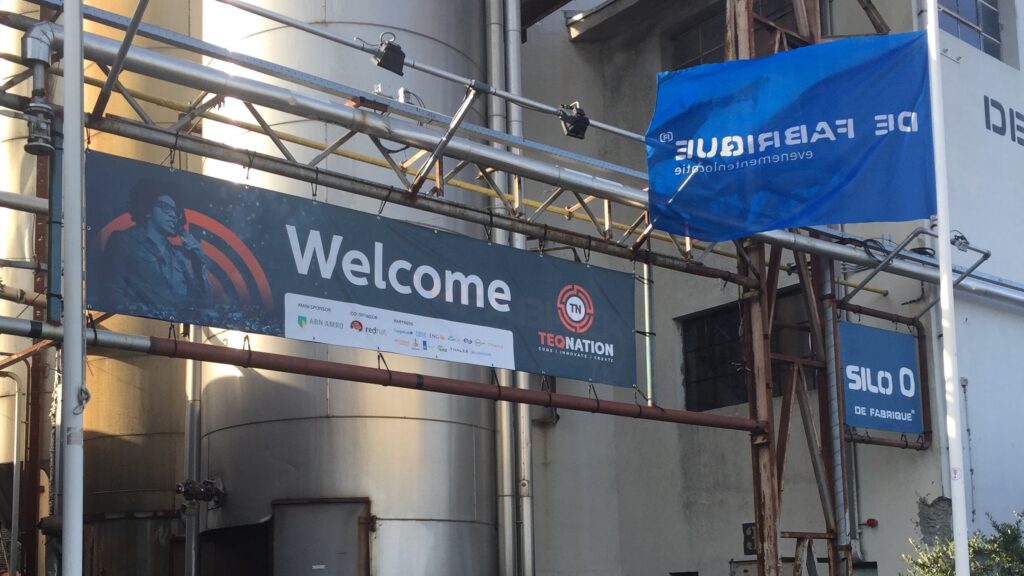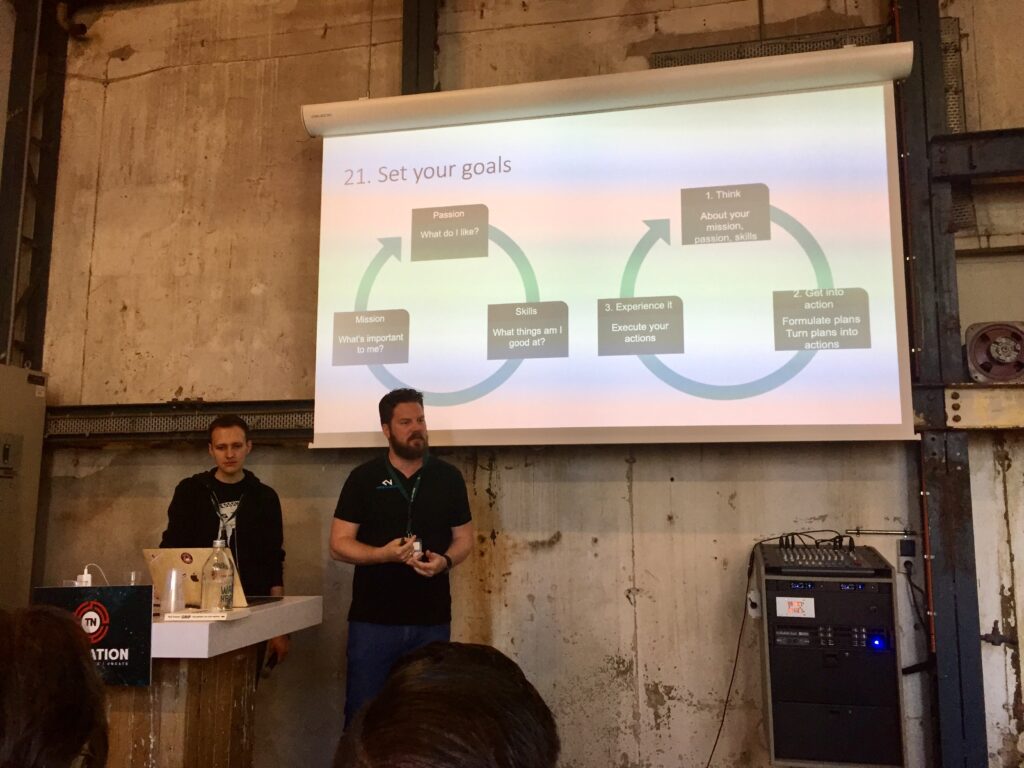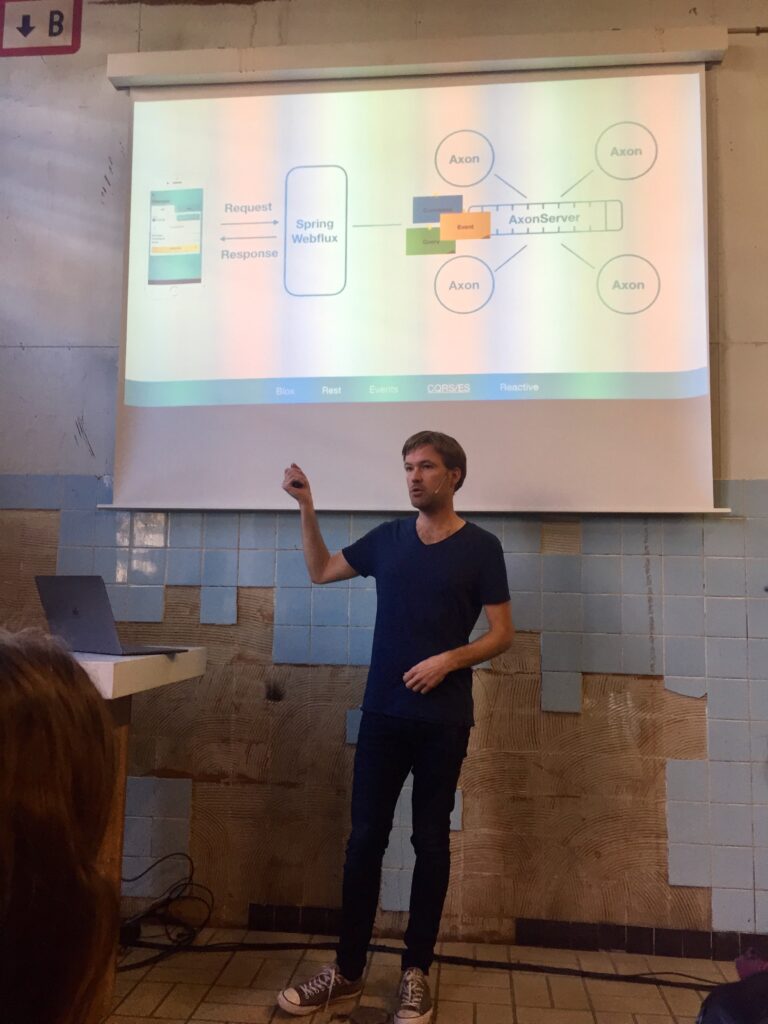Top take-aways from TEQNation

Last week, on May 15, I had the pleasure of attending the TEQNation conference. While I had been to this NLJUG event before, it felt like my first time again. Not only because of the amazing new location—the industrial chic De Fabrique—also because it’s my first time attending as a budding programmer. Although, given the talented individuals I am surrounded by here at Trifork, “programmer” is a label I wear very modestly.
Before taking the plunge into the wonderful world of programming, I studied civil engineering and economics. After a few years working and not really finding a click in either field, I moved to the other side of the world looking for something new. I ended up landing firmly on my feet, picking up work at the GOTO conference, where I caught a severe case of code fever, which doesn’t look like it will be waning anytime soon.
So with this perspective in mind, I’d like to share with you the things that I’ve been reflecting on the most since attending TEQNation.
1. Say no to sponsored key notes
Let’s get the negatives out of the way so we can only head up. My biggest disappointment of the entire day came from the first keynote. Hard to blame ABN AMRO for doing so, but their “keynote” was a thinly-veiled recruitment drive. Yes, it is hard to find good developers in the Netherlands. Yes, there is a hive of start up activity that can be hard to compete with when they have little cultural and technical debt. But flashing a CI/CD pipeline and saying 5+ times that you no longer need to wear a suit and instead wear “agile sneakers” is not the way forward. The line “I couldn’t find the cool Tikkie video with English subtitles” (at an English-speaking conference) instead spoke volumes in the opposite direction.
This talk made me a bit sad because I do know that ABN AMRO are doing some cool technical stuff, particularly when it comes to mobile (and no, I don’t just mean Tikkie). I would have liked to hear more about their technical journey, which their successor, Dave Zolotusky of Spotify, did a much better job of.
2. Expect that failures will happen, aim for a fast recovery
One of the things I have noticed about software, is that it is an excellent metaphor for life. In the best companies, like Trifork (shameless plug), learning through failure is actively encouraged (as long as it’s sandboxed). This mantra applies not only to people, but also to systems. Orchestrated Cloud-based systems are increasingly built in such a way that failure is business as usual. In the Cloud, computing resources can be made (un)available in milliseconds, and modern applications need to be built to reflect that reality. That was a technical lesson that was learned at Spotify.
As someone with a strong fear of failure and can easily fall victim to analysis paralysis, this is also an excellent life lesson, and one of the reasons I love the software industry so much.
3. Hack your productivity and set your own priorities
In what turned out to be an unexpectedly wonderful theme of the conference, was self care and productivity, which was rooted in knowing yourself and how you work.
It started bright and early at 9am, with a declaration from Ramon Wieleman:
“During your studies, you get taught what you need to know for work, but not actually how to work”
After that preposition, Ramon and his co-speaker Artem Makarov (both from CodeNomads), filled the gaps and showed us bleary-eyed-coffee-drinkers how to “Get Shit Done”. It was a dense talk, with the tips and tricks coming thick and fast. Overall the focus of the talk was on setting your own clear goals and priorities, then executing. The unique and most important part was to not to lose yourself in the process. Perhaps a better title for this talk would have been “Get the Right Shit Done”.

A study presented in the talk found that Information overload is the highest in IT, with the number of cases of burnout across all professions rising 1% per year. As we receive increasing amounts of information in an increasing number of ways, our stone-age minds have a hard time keeping up. In addition to setting your own priorities, it pays to find out what’s distracting you, and actively thinking how you can mitigate the distraction. Use a screen time app to help you in the analysis. You will likely be horrified.
Thankfully the slides are pretty detailed and can be found on slideshare.
3. Look after yourself and set realistic expectations
After a long morning and a carby lunch on an empty stomach (was I the only one who wondered where morning snacks were at?), I was looking forward to some inspirational keynotes. I was not disappointed. In “Listen to Dad”, Marcus Biel details his journey from a workaholic junior developer getting nowhere to a balanced senior, who takes the time for himself to get more done. “Dad’s” top advice?
- Sleep, exercise and eat well: stop telling yourself that you don’t have time
- Learn the difference between positive and negative stress
- Set goals, plan to act, then act!
- Done is better than perfect
- Success is a million small steps, never give up
- Invest time and money on yourself, your learning and your career
Even though I have heard many of these before, I will be treating this as a checklist next time things aren’t going the way I want.
5. Tech might actually save the world
The second afternoon keynote was also notable, with Tim van Deursen telling some stories, related to some awesome VR projects he has been involved with as part of the Hack the Planet initiative. From tackling rhinoceros poaching in Africa to combating elderly loneliness, Hack the Planet lends a helping technical hand to existing NGOs so they can approach their problems from a new perspective. How exactly? Well in the case of poaching, the HTP team in conjunction with a local NGO are making smart use of poachers’ mobile phone location data. This way they can track their movements, and stay one step ahead in the fight to save the rhinos. In my view, partnerships like these are the way to take humanity forward.
6. Understanding the basics of Neural Networks can be easy and fun
Martin Foertsch and Thomas Endres of TNG Technology Consulting never disappoint with their talks. I first encountered their Project Avatar talk when I hosted a meetup with them in 2018. The next day I caught them at TEQNation and saw their Hololens talk. The thing I like about these two is that it is clear that they have worked a lot together as their talks flow almost banter-like in an easy back and forth. They also make a lot of effort to explain very complex topics in an accessible and fun way, using their own work and experimentation as a backdrop.
This time the topic was real-time style transfer. This technique makes it possible to create a patchwork (or pastiche) from two images. While one of these images defines the artistic style of the result picture, the other one is used for extracting the image content (see example below). This technique is quite hot in the AI field, and provided the perfect context from which to explain the fundamentals of neural networks to the audience.


Watch the full talk here (recorded at Devoxx) and create your own images at deepart.io
7. The gap between the front end and back end is closing
Whether you agree with the above premise or not, this talk itself was excellent and a prime example of sponsored talks done right. After the obligatory introduction of how De Volksbank approaches IT across multiple brands (interesting it and of itself), Daniël Wedema’s talk ended with a nice demo. At De Volksbank, a common UX team creates modules or assets that have a similar feel but can be tweaked to match the brand colours, content and conventions. This approach means that back-end developers can largely write front-end code using TypeScript in a way that feels like back-end code using dependency injections and mocks. Further, using TypeScript in this way turns many runtime errors that you would otherwise experience in JavaScript into compile-time errors. In Daniel’s words: “as a back-end developer, this makes me happy”, and I tend to agree.
8. Trifork is actually doing cool stuff!

Call me biased as a friend, colleague or Trifork employee, but Erwin De Gier’s talk really stood out. Not only because Erwin is a professional speaker, telling a nice story within a clear structure, but the project he and his team built is really cool. Using Event Sourcing and Reactive Programming via the Axon Framework and Spring WebFlux, the BLOX platform is truly bleeding-edge allowing the everyday investor as well as brokers to invest in cryptocurrency markets. The unique solution means that each service, for example ledger, user, market data order process etc, can instantaneously derive their state from events in the append-only event log. This allows for a high number of transactions that can be instantly validated without having to go through a third party such a bank.
Conclusion
I hope you found this review, tips and resources useful. The key thing I aim to get from conferences is an “index” of where to look for guidance when I encounter problems in the future. After TEQNation 2019, I know that for productivity hacks, I can go to Ramon and Artem. When my static html pages no longer cut it, I can reach for TypeScript with confidence knowing that I can avoid some of the runtime pain of JavaScript. Or, if I am having a bad day and am questioning my career choices, then I can remind myself of my goals and the cool work Trifork is doing, or look a little wider to Hack the Future.